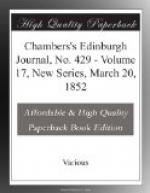A crowd of ladies were watching with great attention the Sewing-machine—sewing away with the greatest exactness, and much stronger than by the ordinary mode with a needle, as each stitch is a knot. The inventor was shewing it; and he said he had nearly completed a machine for the button-holes. The next was a machine called ’The Man’—and truly named, for a more marvellous production can scarcely be conceived—for making implements for carding wool or cotton, the article passing in as raw wire, going through before our eyes four processes of the most delicate description, and finally coming out a perfect card, with its wire-teeth exactly set, and ready for use. My attention was drawn to the application of the Jacquard principle to a loom engaged in weaving a calico fabric, of various colours woven with a pattern, and thus producing an elegant article, thick, and well adapted for bed-furniture. But the most curious and simple, and withal, perhaps, the most important invention for facilitating manufactures, is what is called the ‘Turpin Wheel,’ taking its name from the inventor. How simple may be the birth of a great idea! We all observe that a log under a waterfall, coming down perpendicularly upon it, spins round, as on an axis, till it escapes. This led to the invention in question. The water falls upon the spokes of a horizontal wheel, which it sends round with great velocity; and by this contrivance the force of the water is more than doubled. I must not omit to mention the machine just invented for weaving the fabric we call Brussels carpeting. This machine will weave twenty yards of carpeting per day, with one female to attend it. The carpet is worth 3s. per yard, while the wages paid for human aid in its production is 1-1/4d. per yard: machinery can go little further. Let me add, that I was informed that everything on this floor was the invention of working-men.
Upon ascending to the first floor, I found the apartment arranged with stands—each stand devoted to one sort of manufacture—and attended, as below, by an intelligent person, to shew and explain. Here was every description of furniture, cotton, and woollen fabric; but neither velvets nor silks, which have not, as yet, been introduced. We know so much of our doings in England in the woollen and cotton line, that my attention was principally attracted to these specimens. Here was everything except the broad-cloths—all the patterns of plaid-shawls, so beautifully imitated and executed, that they would, I am sure, pass in Edinburgh. I saw the kerseymere fabric that obtained the prize in London, and nothing could be more beautiful; for the calicoes, I believe we cannot produce them cheaper or better. A writer in a journal here, observes: ’Why should our cotton go to England to be spun when we can spin it in Massachusetts?’ A very pertinent question, well worth thinking of at home. We should be thankful to the projectors of the Crystal Palace, that it has opened our eyes, for nothing else could. There is no manner of doubt, that we can learn something beyond yacht-sailing; but we shall not open our eyes to the widest until the arrival in our market of the first cargo of manufactured woollens and cottons; and as surely as we have barrels of flour and pork, we shall soon find them with us: I saw first-rate calico, which could be sold at 2d. per yard.




